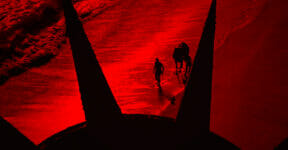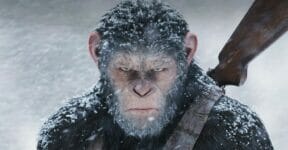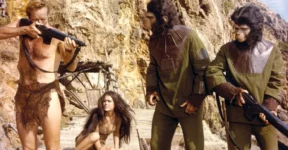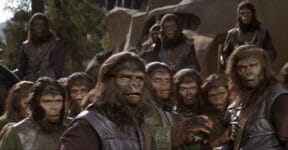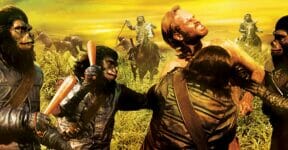The original Planet of the Apes (1968) was pretty much a gamble from the perspective of 20th Century Fox. Other studios rejected the idea of a film in which actors were required to dress up as animals. There had been B-movies of a similar sort before; many of them triggered laughter from viewers and were ridiculed by critics. Fox was also initially reluctant until the studio learned the film had been linked to some of Hollywood’s biggest names, including Charlton Heston as the lead character and Rod Serling to handle the scriptwriting. The studio ended up giving the production team a budget of $5.8 million to get the project done. It paid off and then some. Planet of the Apes earned more than $30 million worldwide and was all ripe for a sequel.

Beneath the Planet of the Apes would be the first of four sequels released in just several years, from 1970 to 1973. The production team underwent some major overhauls. Actor Roddy McDowell was unable to return for the sequel because of a prior commitment to another project; the script originally drafted by Rod Serling was later heavily revised by Paul Dehn; and director Ted Post, by then fresh off Hang ’em High, replaced Franklin J. Schaffner.
The first sequel starts exactly where the original left off. Astronaut George Taylor and a primitive human named Nova escape into the Forbidden Zone, which is a territory believed to be formerly inhabited by modern civilized people instead of apes. In an attempt to investigate the sight of a massive rock cliff in an otherwise almost total wasteland of debris and ash, Taylor disappears.
Nova heads back toward the Ape City and stumbles upon another astronaut, John Brent (James Franciscus). As it turns out, Brent is sent from Earth on an expedition mission to locate Taylor and his crew. Nova takes Brent on her journey back to meet friendly chimpanzee scientists, Dr. Cornelius and Dr. Zira. Since the ape military forces are actively seeking humans in the city, Nova and Brent again must escape the search party. They end up in an underground city, inhabited by survivors of a nuclear holocaust—human mutants with telepathic ability and worshippers of an active atom bomb. As the ape military plans for an invasion into the Forbidden Zone, the mutants also are preparing for war.
Time to Kill
Despite having a different director and screenwriter, the original film and its sequel seem to use the same exact premise. There is a male astronaut, accompanied by a primitive woman, on the run from aggressive apes. Two sympathetic chimpanzees help the humans escape the hunt. The similarity brings about a storytelling awkwardness because Beneath the Planet of the Apes is meant to be a direct sequel.

The real progress to the plot point is the ending scene of the first film as it begins when Brent reaches the underground city. In between his arrival and the discovery of underground-dwelling mutants, there is a good 40-minute period filled with a retelling of the original story. The problem is the audience already knows about the Ape City, its ruling society, and the relationship between apes and humans. And the protagonist Brent is the only person unaware of the situation. For more than half an hour, Beneath the Planet of the Apes is a re-run of the cat-and-mouse game played earlier by Taylor and Zaius. Over the course of the film, Brent needs to convincingly wonder, “What’s happening?”
Inside the Forbidden Zone
Beneath the Planet of the Apes gives a more detailed explanation of the Forbidden Zone. In the original film, Taylor discovers various human artefacts, such as a talking doll and dentures. Taylor eventually realizes that he has always been on Earth, albeit in the distant future in the aftermath of a nuclear apocalypse where apes take over humans as the dominant species.

The sequel sends Taylor, Brent, and Nova deep into the region. A large group of human mutants live in the caves underneath the barren wasteland, as a cult-like society that worships a nuclear bomb. The Forbidden Zone remains a radioactive area even centuries after the nuclear disaster. It is likely the ape society never enters the area because the mutants’ telepathic abilities affect the apes’ senses or simply because the radiation level is too high and makes them sick.
Great Second Half
After Brent and Nova discover the entrance into the cave, the film really starts to come into its own. If the original film gives a lot of attention to the apes and how they run society as a ruling species, the second half of the sequel takes the spotlight away from them. Dominant apes make the original an exciting watch; they are fascinating villains and worthy adversaries to a proud resourceful American astronaut. Now, there is another group of war-mongering characters.

The idea of intelligent humans surviving a nuclear disaster is unthinkable, which turns out to be a big element of surprise in the sequel. Some people were still alive following the disaster. The underground city is now inhabited by their descendants; they are mutants with telepathic powers. Another good thing is that Beneath the Planet of the Apes doesn’t care about further development. Moments after Heston made a brief return in the climactic scene, the bomb worshipped by the mutants exploded, destroying the world once again. The story should end here since the planet is reduced to oblivion.
The Stars
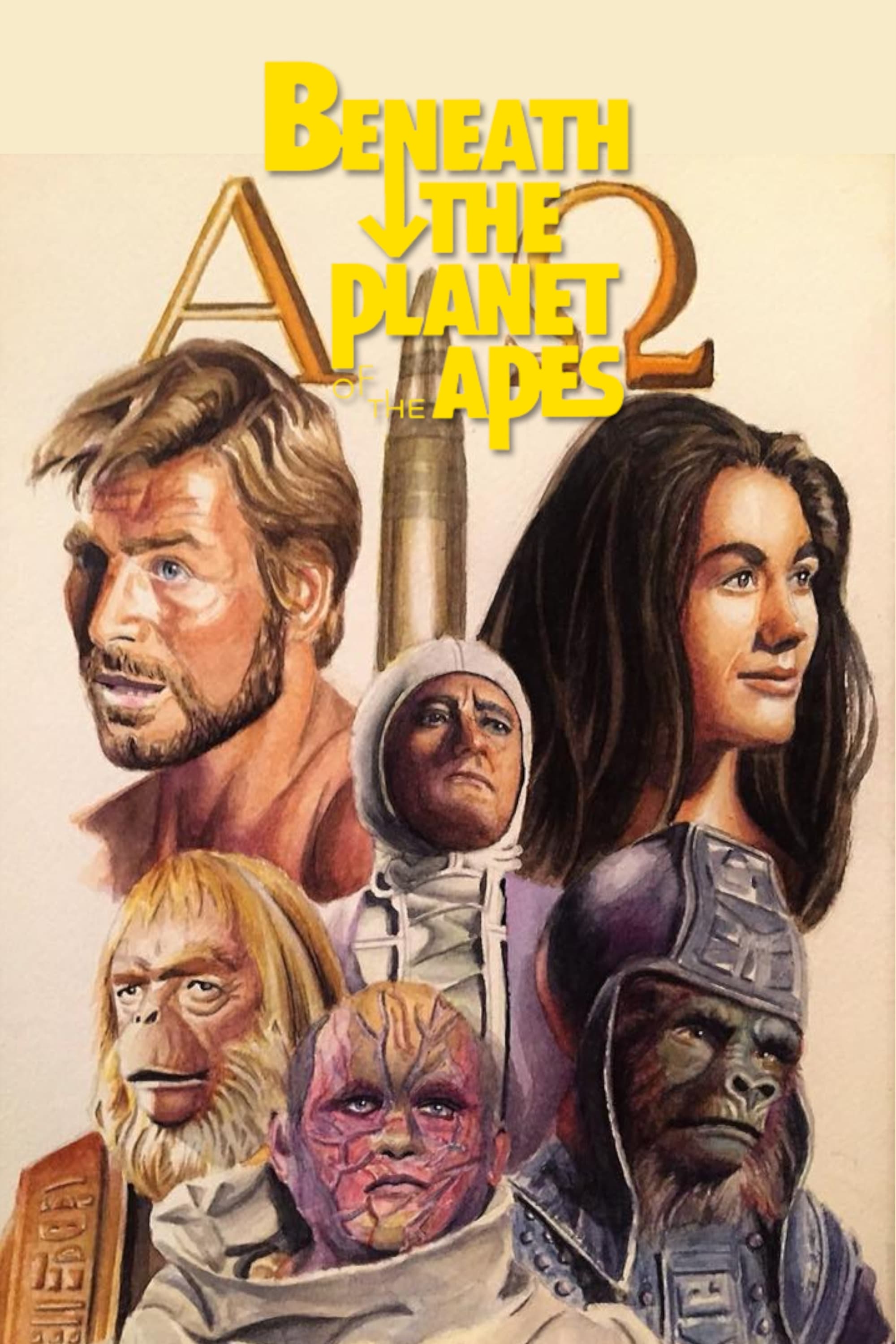
Charlton Heston famously rejected reprising his role in the sequel. He only agreed to take part in the project as long as his character appeared briefly and died, which Taylor did. Director Franklin J. Schaffner as well as Roddy McDowell, could not commit themselves to the sequel for they had already signed-up for different projects.
James Grover Franciscus
The lead character in Beneath the Planet of the Apes is John Brent, also an astronaut, portrayed by James Franciscus. Thanks to Heston’s reluctance to play in the sequel, the screenplay for the main character had to be rewritten for Brent. Throughout the decades of his acting career, Franciscus was more famously known for his roles in TV series such as Naked City, The Investigators, Mr Novak, Longstreet, Doc Elliot, and Hunter.
David Watson
Roddy McDowell was also unable to reprise his role as Dr. Cornelius in the sequel, and the character was subsequently given to David Watson. Starting as a professional singer, he made a swift transition to stage acting. He went on to play in TV shows including The Girl from U.N.C.L.E and Daniel Boone. Watson also played the titular role in the musical The Legend of Robin Hood.
James Gregory
The primary antagonist is General Ursus, portrayed by James Gregory, best known for his roles as Schaffer in Al Capone and as Senator John Iselin in The Manchurian Candidate. Gregory appeared as supporting/recurring characters in various TV series including Hawaii Five-O and Barney Miller.
Maurice Evans, Kim Hunter, and Linda Harrison reprise their roles as Dr. Zaius, Dr. Zira, and Nova, respectively.
Are you as big a POTA fan as we are? Tell us what you think of the original cast. We’d love to hear from you.
Other things you might want to know:
Is Beneath the Planet of the Apes a book?
The novelization of the film by Michael Avallone retained the original scripted ending. Brent does not kill General Ursus. Taylor confronts him and Dr Zaius. As Taylor tries to reason with Zaius, Zaius condemns him and Ursus repeatedly shoots Taylor with his pistol; Brent’s rifle empties and the gorillas kill him. Ursus is horrified, telling Zaius that he has emptied the pistol into Taylor; he should be dead, but he still lives. Knowing he is dying, Taylor (after Zaius refuses to help him) decides to stop the violence by detonating the bomb. This he does, destroying the Earth itself.
What are some production details when Beneath the Planet of the Apes began filming?
Production began in February 1969. The sequel, now titled Beneath the Planet of the Apes, had its budget reduced from $5 million to $2.5 million because Fox had suffered recently from several underperforming big-budget films, like Star!, Hello, Dolly! and Tora! Tora! Tora! Nonetheless, the studio expected the film to return Fox to profitability. Heston’s parts were filmed in just eight days. The sets of the mutants’ council chamber and the temple of the bomb were redresses of the Grand Central – 42nd Street station and Harmonia Gardens sets from the film Hello, Dolly!
What was the trivia for Beneath the Planet of the Apes?
Burt Reynolds was considered for the lead role of John Brent before James Franciscus was cast due to his resemblance to Charlton Heston. Don Medford agreed to direct the movie but walked out after the budget was halved. Originally, there was going to be a scene featuring a half-human/half-ape child.
Check out other articles by month:


